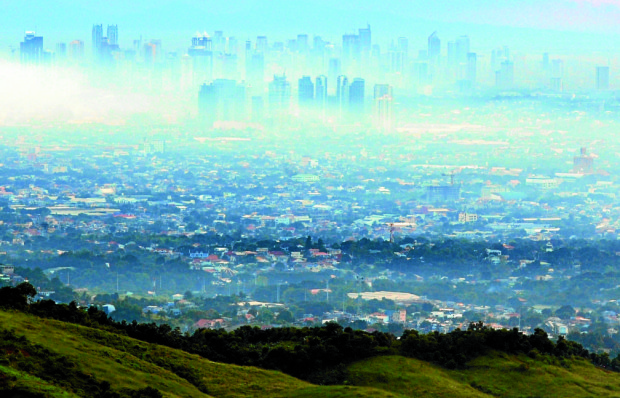Post-revelry air quality ‘unhealthy’ in Metro Manila areas — DENR

SMOG OVER METRO MANILA | As seen from San Mateo, Rizal province, thick smog — a toxic mix of vehicle exhaust, emissions from factories, and other sources of air pollution — covers vast stretches of Metro Manila and environs. (Photo by RICHARD REYES / Philippine Daily Inquirer)
MANILA, Philippines — Several Metro Manila cities greeted the new year with poorer air quality, with some seeing an “acutely unhealthy” level of pollutants, data from the Department of Environment and Natural Resources (DENR) showed.
Based on the 8 a.m. data from the Environmental Management Bureau (EMB), air quality in Mandaluyong City reached an “acutely unhealthy” ambient air quality index (AQI) value of 260, as the monitoring station in the area gathered a high level of suspended particles 10 micrometers or less (PM10) in size like dust from paved and unpaved roadways, no thanks to the traditional burning of fireworks and firecrackers to welcome the new year.
“While some of these particles can be filtered by the body, these can irritate your eyes, nose, and throat,” the DENR explained in an earlier statement.
Based on collected PM10 data, the air quality in the cities of Makati and Pateros was “very unhealthy” while it was “unhealthy for sensitive groups” in Taguig City and Pasig City, and “fair” in Caloocan City and San Juan City.
The monitoring stations in the remaining cities in Metro Manila, however, were offline at the time while Quezon City and Valenzuela City had “no station.”
Article continues after this advertisement‘Emergency’ status
Data from the DENR website showed that Makati City, Pasig City, and Pateros even reached an ambient AQI value of 1,000 with an “emergency” status at 8 a.m. for monitoring stations that collected particles 2.5 micrometers or less (PM2.5).
Article continues after this advertisementThe United States-based Centers for Disease Control and Prevention said these fine particles were “dangerous because they can get into the deep parts of your lungs — or even into your blood.”
While the remarks indicated an “emergency” level in the three areas, the DENR’s data were not color-coded maroon—the identifier for the emergency category in DENR Administrative Order No. 2020-14.
The 1,000 AQI shown in the EMB graphics also exceeded the scale of 0-500.
The Inquirer sought clarification from the DENR but it had yet to respond at press time on Monday.
In Caloocan City, the EMB recorded an air quality value of 106, which is “unhealthy for sensitive groups.”
Under this condition, the DENR cautioned people to limit outdoor exertion while those with heart or respiratory diseases like asthma were advised to stay indoors.
By 10 a.m., the EMB’s updated data for monitoring stations of PM2.5 showed that Pasig City remained at the emergency level while air quality in Makati was acutely unhealthy and fair in Caloocan City and Pateros.
On the other hand, based on PM10 monitoring, air quality in Mandaluyong City slightly improved but was still classified as very unhealthy for sensitive groups.
According to the same indicator, air quality in the cities of Pasig, San Juan, and Makati was seen as “fair” by 10 a.m., while it was “good” in Caloocan City, Taguig City, and Pateros.
Rhea Torres, a weather specialist at the Philippine Atmospheric, Geophysical and Astronomical Services Administration (Pagasa), said they also monitored “thermal inversion” in Metro Manila and parts of Calabarzon (Cavite, Laguna, Batangas, Rizal, Quezon) region resulting in thick smog on Monday.
The DENR-EMB earlier explained that temperature inversion was a natural phenomenon wherein smog — a combination of smoke and fog — and other particulate matter are trapped closer to the ground.
“What happened was that the pollutants or the components in the drying particles of these fireworks, as well as the pollution in our environment, mixed and came together so it was thicker compared to the normal haze or smog that we experience in the last few months,” Torres said in an interview with “Balitanghali.”
She added that both haze and smog are forms of pollution, but that smog was thicker and could reduce visibility.
Fortunately, by 6 p.m., DENR data showed that air quality had improved to “good,” both for PM10 and PM2.5, except for Mandaluyong which showed a “fair” status for the PM10 indicator.